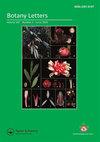广东香蒲的早期叶片发育
IF 1.3
4区 生物学
Q3 PLANT SCIENCES
引用次数: 0
摘要
摘要:香蒲是一种在全球范围内广泛分布的水生植物,作为一种入侵物种,会造成重大影响;这种能力取决于它与叶片相关的光合能力。因此,了解叶片发育对于解释枝条生长及其光合区域的形成至关重要。本研究调查了霸王龙从早期到初级组织完全发育的叶片个体发育。植物是从自然湿地采集并在温室中栽培的。然后选择根状茎,并去除叶片,以使新梢能够出现。每隔1天收集含有叶子的根状茎碎片,直到第7天,并在植物微技术中进行常规程序。沿着根茎的侧芽长出新的叶子。鳞片叶的解剖结构不同于光合叶,因为它们含有没有栅栏薄壁组织的固体内含物。叶原基从茎尖分生组织侧向产生,组织为一个被膜体。最终的叶片形状受到不同分生组织区的影响:叶顶端分生组织、边缘分生组织,肋分生组织和叶间分生组织。除木质部和韧皮部外,大多数叶组织都是基瓣发育的。在叶片开始生长后的七天内,所有的初级组织都发育成熟并具有形态学功能。多米诺香蒲的叶片形成与其他单子叶植物相似。多米诺T.domgensis的叶片发育非常早,提供了功能齐全的光合组织,这可能对其入侵能力有影响。本文章由计算机程序翻译,如有差异,请以英文原文为准。
Early leaf development of Typha domingensis Pers. (Typhaceae)
ABSTRACT Typha domingensis Pers. (cattail) is a globally widespread aquatic plant that causes significant impacts as an invasive species; this ability is dependent on its photosynthetic capacity that is related to leaves. Thus, understanding leaf development is essential for interpreting shoot growth and the formation of its photosynthetic area. This study investigates leaf ontogeny in T. domingensis from early stages until complete development of primary tissues. Plants were collected from natural wetlands and cultivated in a greenhouse. Rhizomes were then selected, and leaves were removed to enable the emergence of new shoots. Rhizome fragments containing leaves were collected at 1-day intervals until day 7 and were subjected to routine procedures in plant microtechnique. New leaves emerged from lateral buds located along the rhizome. The anatomy of scale leaves differs from that of photosynthetic leaves since they contain solid inclusions without palisade parenchyma. Leaf primordia arose laterally from the shoot apical meristem, which was organized as a tunica-corpus. Final leaf shape was influenced by different meristematic zones: the leaf apical meristem, the marginal meristem, the rib meristem, and intercalary meristems. Most leaf tissues developed basipetally, except for xylem and phloem. Within seven days following leaf initiation, all primary tissues were developed and morphologically functional. Leaf formation of Typha domingensis is similar to that of other monocot species. Leaves of T. domingensis develop very early, providing fully functional photosynthetic tissues, which may have implications for its invasive capacity.
求助全文
通过发布文献求助,成功后即可免费获取论文全文。
去求助
来源期刊

Botany Letters
Agricultural and Biological Sciences-Plant Science
CiteScore
3.10
自引率
6.70%
发文量
54
期刊介绍:
Botany Letters is an international scientific journal, published by the French Botanical Society (Société botanique de France) in partnership with Taylor & Francis. Botany Letters replaces Acta Botanica Gallica, which was created in 1993, building on over a century of renowned publications by the Société botanique de France.
 求助内容:
求助内容: 应助结果提醒方式:
应助结果提醒方式:


